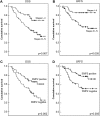Loss of epithelial membrane protein-2 expression confers an independent prognosticator in nasopharyngeal carcinoma: a cohort study
- PMID: 22492389
- PMCID: PMC3323806
- DOI: 10.1136/bmjopen-2012-000900
Loss of epithelial membrane protein-2 expression confers an independent prognosticator in nasopharyngeal carcinoma: a cohort study
Abstract
Objective: To evaluate the expression of epithelial membrane protein-2 (EMP2) protein and its clinicopathological associations in patients with nasopharyngeal carcinoma.
Design: Retrospective population-based cohort study.
Setting: This study was based on a biobank in Chi-Mei Medical Center (Tainan, Taiwan) from 1993 to 2002.
Participants: Biopsies of 124 consecutive nasopharyngeal carcinoma patients without initial distant metastasis and treated with consistent guidelines were assessed. Immunoexpressions of EMP2 were analysed and the outcomes were correlated with clinicopathological features and patient survivals.
Primary and secondary outcome measures: Immunoexpressions of EMP2 were analyzed and the outcomes were correlated with clinicopathological features and patient survivals.
Results: Loss of EMP2 expression (49.2%) was correlated with advanced primary tumour (p=0.044), nodal status (p=0.045) and the 7th American Joint Committee on Cancer stage (p=0.027). In multivariate analyses, loss of EMP2 expression emerged as an independent prognosticator for worse disease-specific survival (DSS; p=0.015) and local recurrence-free survival (LRFS; p=0.030), along with the American Joint Committee on Cancer stages III-IV (p=0.034, DSS; p=0.023, LRFS).
Conclusions: Loss of EMP2 expression is common and associated with adverse prognosticators and might confer tumour aggressiveness through hampering its interaction with specific membrane protein(s) and hence the downstream signal transduction pathway(s).
Conflict of interest statement
Figures


Similar articles
-
The Multifaceted Role of Epithelial Membrane Protein 2 in Cancer: from Biomarker to Therapeutic Target.Biomol Ther (Seoul). 2024 Nov 1;32(6):697-707. doi: 10.4062/biomolther.2024.168. Epub 2024 Oct 21. Biomol Ther (Seoul). 2024. PMID: 39428387 Free PMC article. Review.
-
Expression of cyclin-dependent kinase 2-associated protein 1 confers an independent prognosticator in nasopharyngeal carcinoma: a cohort study.J Clin Pathol. 2012 Sep;65(9):795-801. doi: 10.1136/jclinpath-2012-200893. Epub 2012 Jul 12. J Clin Pathol. 2012. PMID: 22791769
-
Associations of Rsf-1 overexpression with poor therapeutic response and worse survival in patients with nasopharyngeal carcinoma.J Clin Pathol. 2012 Mar;65(3):248-53. doi: 10.1136/jclinpath-2011-200413. Epub 2011 Nov 12. J Clin Pathol. 2012. PMID: 22081787
-
Overexpression of thymidylate synthetase confers an independent prognostic indicator in nasopharyngeal carcinoma.Exp Mol Pathol. 2013 Aug;95(1):83-90. doi: 10.1016/j.yexmp.2013.05.006. Epub 2013 May 28. Exp Mol Pathol. 2013. PMID: 23726796
-
Overexpression of CDC28 protein kinase regulatory subunit 1B confers an independent prognostic factor in nasopharyngeal carcinoma.APMIS. 2014 Mar;122(3):206-14. doi: 10.1111/apm.12136. Epub 2013 Jul 24. APMIS. 2014. PMID: 23879533
Cited by
-
The Multifaceted Role of Epithelial Membrane Protein 2 in Cancer: from Biomarker to Therapeutic Target.Biomol Ther (Seoul). 2024 Nov 1;32(6):697-707. doi: 10.4062/biomolther.2024.168. Epub 2024 Oct 21. Biomol Ther (Seoul). 2024. PMID: 39428387 Free PMC article. Review.
-
Expression of EMP 1, 2, and 3 in Adrenal Cortical Neoplasm and Pheochromocytoma.Int J Mol Sci. 2023 Aug 21;24(16):13016. doi: 10.3390/ijms241613016. Int J Mol Sci. 2023. PMID: 37629198 Free PMC article.
-
Review of the GAS3 Family of Proteins and their Relevance to Cancer.Crit Rev Oncog. 2015;20(5-6):435-47. doi: 10.1615/CritRevOncog.v20.i5-6.140. Crit Rev Oncog. 2015. PMID: 27279240 Free PMC article. Review.
References
-
- Chang ET, Adami HO. The enigmatic epidemiology of nasopharyngeal carcinoma. Cancer Epidemiol Biomarkers Prev 2006;15:1765–77 - PubMed
-
- Yu MC, Yuan JM. Epidemiology of nasopharyngeal carcinoma. Semin Cancer Biol 2002;12:421–9 - PubMed
-
- Liebowitz D. Nasopharyngeal carcinoma: the Epstein-Barr virus association. Semin Oncol 1994;21:376–81 - PubMed
-
- Lo KW, To KF, Huang DP. Focus on nasopharyngeal carcinoma. Cancer Cell 2004;5:423–8 - PubMed
-
- Fang FM, Chien CY, Li CF, et al. Effect of S-phase kinase-associated protein 2 expression on distant metastasis and survival in nasopharyngeal carcinoma patients. Int J Radiat Oncol Biol Phys 2009;73:202–7 - PubMed
LinkOut - more resources
Full Text Sources
Molecular Biology Databases
